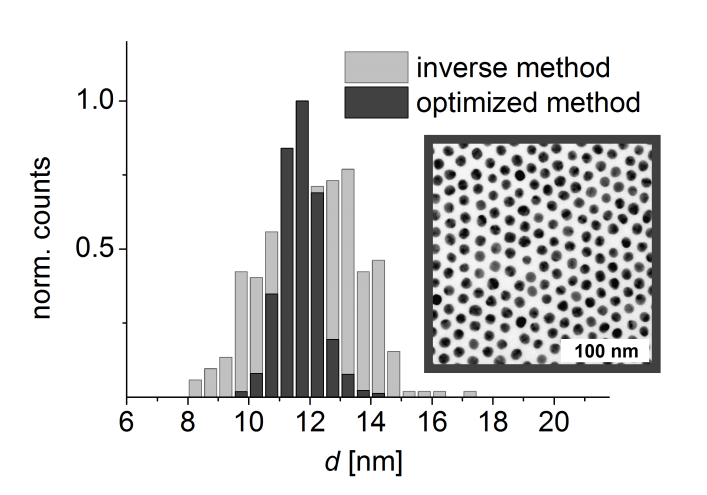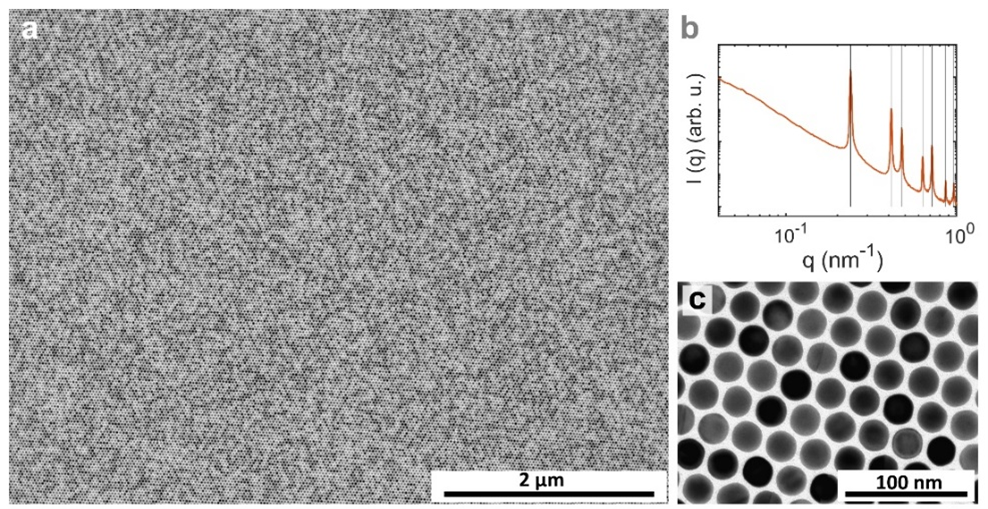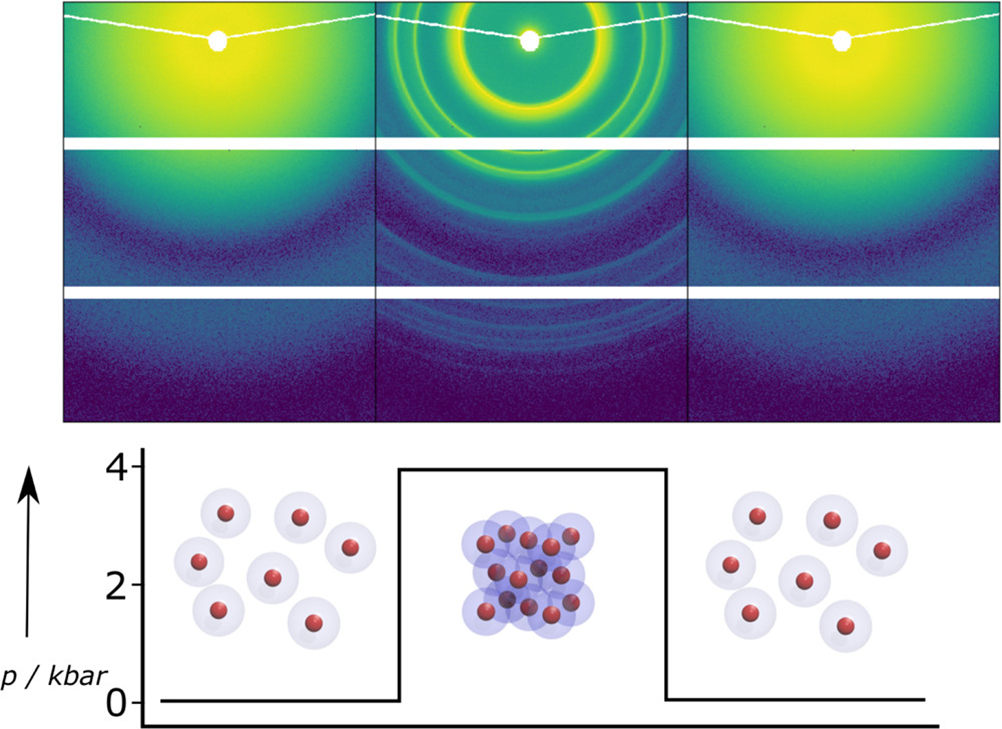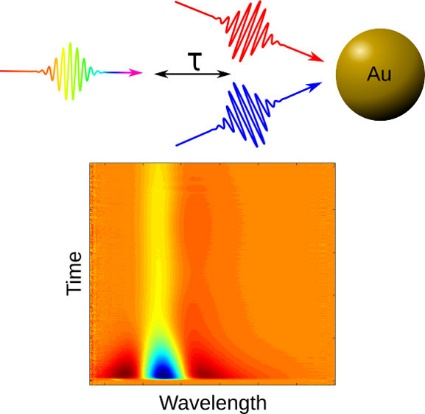Research of Dr. Florian Schulz & team
Our highly interdisciplinary research is centered around nanoparticles and their assemblies as well as their structure and dynamics. It wouldn’t be possible without excellent cooperations and students. If you are interested in doing a thesis on these topics feel free to reach out!
Synthesis and Surface Chemistry of Nanoparticles
We have extensive expertise in the synthesis, functionalization and characterization of gold nanoparticles (AuNP), but also other metal, metal-oxide, semiconductor and carbon nanomaterials with different sizes and shapes. We developed simple and robust syntheses of AuNP, that are now a reference in terms of size reproducibility, dispersity and uniformity, and PEG-based ligands that provide nanoparticles of different size, shape and materials with excellent chemical and colloidal stabilization. This is of outmost importance in the context of nanomedicine and for the synthesis of highly defined superlattices.
Key publications:
- Hoeg, F.; Schulz, J.; Graf, S.; Salah, D.; Chandralingam, S.; Maison, W.; Parak, W. J.; Schulz, F., Defined Coadsorption of Prostate Cancer Targeting Ligands and PEG on Gold Nanoparticles for Significantly Reduced Protein Adsorption in Cell Media. Journal of Physical Chemistry C 2022, 126 (48), 20594-20604. https://pubs.acs.org/doi/10.1021/acs.jpcc.2c05415#Abstract
-
Schulz, F.; Friedrich, W.; Hoppe, K.; Vossmeyer, T.; Weller, H.; Lange, H., Effective PEGylation of gold nanorods. Nanoscale 2016, 8, 7296 https://pubs.rsc.org/en/content/articlehtml/2016/nr/c6nr00607h
- Schulz, F.; Dahl, G. T.; Besztejan, S.; Schroer, M. A.; Lehmkühler, F.; Grübel, G.; Vossmeyer, T.; Lange, H., Ligand Layer Engineering To Control Stability and Interfacial Properties of Nanoparticles. Langmuir 2016, 32 (31), 7897–7907. https://pubs.acs.org/doi/full/10.1021/acs.langmuir.6b01704
- Schulz, F.; Vossmeyer, T.; Bastus, N. G.; Weller, H., Effect of the Spacer Structure on the Stability of Gold Nanoparticles Functionalized with Monodentate Thiolated Poly(ethylene glycol) Ligands. Langmuir 2013, 29 (31), 9897-9908. https://pubs.acs.org/doi/full/10.1021/la401956c
Contributing theses: Torge Homolka (Bachelor), Niklas Lucht (Bachelor), Sebastian Graf (Master), Konstantin Krutzke (Bachelor), Elif Metin (Bachelor), Marcus von der Au (Bachelor), Gregor T. Dahl (Bachelor), Jennifer Schulz (Master)
Superlattices of AuNP with emergent plasmonic properties

We developed robust protocols for the preparation of record scale and quality plasmonic superlattices and supercrystals. These superstructures show extreme light-matter interactions like deep strong coupling at room temperature, which represents a breakthrough achievement. The collective plasmonic properties observed in these supercrystals are truly emergent and are contingent upon the order and geometry of the structures. By manipulating the geometry, we can tune the coupling strength and plasmonic band structure, offering unparalleled opportunities for nanoscale light-matter coupling. However, achieving the necessary quality and geometries for detailed studies was previously unattainable. Accurate structural characterization is therefore crucial, and we have successfully accomplished this through experiments conducted at synchrotron sources such as the Deutsche Elektronen-Synchrotron (DESY) in Hamburg. Current research efforts focus on more complex superstructures and their optical and thermal properties and applications in surface-enhanced spectroscopies and catalysis.
Key publications:
- Marcone, J.; Juergensen, S.; Barrios-Capuchino, J.; Li, X.; Goldmann, C.; Köppen, A.; Pfeiffer, W.; Lehmkühler, F.; Parak, W. J.; Kociak, M.; Impéror-Clerc, M.; Reich, S.; Hamon, C.; Schulz, F., Plasmonic Polymorphs by Combining Shape Anisotropy and Soft Interactions in Bipyramid Thin Films. Small 2025, 21 (31), 2500389. https://onlinelibrary.wiley.com/doi/full/10.1002/smll.202500389
- Herran, M.; Juergensen, S.; Kessens, M.; Hoeing, D.; Köppen, A.; Sousa-Castillo, A.; Parak, W. J.; Lange, H.; Reich, S.; Schulz, F.; Cortés, E., Plasmonic bimetallic two-dimensional supercrystals for H2 generation. Nature Catalysis 2023, 6 (12), 1205-1214. https://www.nature.com/articles/s41929-023-01053-9#Ack1
- Mueller, N. S.; Pfitzner, E.; Okamura, Y.; Gordeev, G.; Kusch, P.; Lange, H.; Heberle, J.; Schulz, F.; Reich, S., Surface-Enhanced Raman Scattering and Surface-Enhanced Infrared Absorption by Plasmon Polaritons in Three-Dimensional Nanoparticle Supercrystals. ACS Nano 2021, 15 (3), 5523-5533. https://pubs.acs.org/doi/full/10.1021/acsnano.1c00352
- Schulz, F.; Pavelka, O.; Lehmkuhler, F.; Westermeier, F.; Okamura, Y.; Mueller, N. S.; Reich, S.; Lange, H., Structural order in plasmonic superlattices. Nat. Commun. 2020, 11 (1), 3821-(1-9). https://www.nature.com/articles/s41467-020-17632-4
- • Mueller, N. S.; Okamura, Y.; Vieira, B. G. M.; Juergensen, S.; Lange, H.; Barros, E. B.; Schulz, F.; Reich, S., Deep strong light-matter coupling in plasmonic nanoparticle crystals. Nature 2020, 583 (7818), 780-784. https://www.nature.com/articles/s41586-020-2508-1
Contributing theses: Finn Dobschall (Bachelor), Lukas Mielke (Bachelor), Juan Barrios-Capuchino (PhD), Sarodi Jonak Dutta (PhD, ongoing), Luisa Wartner (Bachelor), Marius Thiem (Bachelor), Samira Beiki (Master), Zahra Arabi (Master), Shivani Kesarwani (now University of Potsdam, ongoing)
Coherent X-ray scattering studies

The capability to synthesize nanoparticles with low dispersity and high stability, even at very high concentrations, has enabled the investigation of fascinating dispersion behaviors in situ at synchrotron sources, even under extreme conditions such as high hydrostatic pressures. Additionally, our research has unveiled the thermo-reversible formation of colloidal gels, which we studied using X-ray photon correlation spectroscopy (XPCS) to obtain correlation functions describing the system dynamics across relevant time scales.
Plasmonic supercrystals as described above are analyzed using thin-film scanning small-angle X-ray scattering (SAXS) in conjunction with X-ray cross-correlation analysis (XCCA). By correlating electron microscopy with SAXS at microscopic regions of interest, we are able to discern sub-nanometer features in a statistically robust manner.
These examples underscore the significant synergistic potential of utilizing AuNP, strong scatterers, in state-of-the-art coherent SAXS-based experiments. AuNP serve as excellent model systems, functioning both as inert tracer particles in dynamics studies and as tools for elucidating the structure and dynamics of materials including complex biological systems.
Key publications:
- Jain, A.; Schulz, F.; Lokteva, I.; Frenzel, L.; Grubel, G.; Lehmkuhler, F., Anisotropic and heterogeneous dynamics in an aging colloidal gel. Soft Matter 2020, 16 (11), 2864-2872. https://pubs.rsc.org/en/content/articlelanding/2020/sm/c9sm02230a
- Schulz, F.; Lokteva, I.; Parak, W. J.; Lehmkuhler, F., Recent Notable Approaches to Study Self-Assembly of Nanoparticles with X-Ray Scattering and Electron Microscopy. Part. Part. Syst. Charact. 2021, 38 (9), 2100087-(1-28). https://onlinelibrary.wiley.com/doi/full/10.1002/ppsc.202100087
- •Otto, F.; Dallari, F.; Westermeier, F.; Wieland, D. C. F.; Parak, W. J.; Lehmkühler, F.; Schulz, F., The dynamics of PEG-coated nanoparticles in concentrated protein solutions up to the molecular crowding range. Aggregate 2024, 5 (3), e483. https://onlinelibrary.wiley.com/doi/full/10.1002/agt2.483
Contributing theses: Ferdinand Otto (PhD), Jette Bleicken (Master), Robbert Schütt (PhD, ongoing)
Pump probe experiments

The precise control of AuNP size, uniformity, dispersity, and crystallinity facilitated systematic studies of plasmon relaxation, crucial for plasmonic photocatalysis. Through transient absorption spectroscopy we untangled band transitions' and plasmonic absorption's contributions to hot electron generation by quantifying electron-phonon coupling. High-resolution structural insights from experiments at free-electron lasers (FLASH and European XFEL, Hamburg) refined our understanding of hot electron generation and relaxation. Additionally, utilizing AuNP as stable tracer materials, we contributed to single-particle imaging (SPI) studies (European XFEL, Hamburg), promising advancements in SPI with biologically relevant structures.
Key publications:
-
Hoeing, D.; Salzwedel, R.; Worbs, L.; Zhuang, Y. L.; Samanta, A. K.; Lubke, J.; Estillore, A. D.; Dlugolecki, K.; Passow, C.; Erk, B.; Ekanayake, N.; Ramm, D.; Correa, J.; Papadopoulou, C. C.; Noor, A. T.; Schulz, F.; Selig, M.; Knorr, A.; Ayyer, K.; Kupper, J.; Lange, H., Time-Resolved Single-Particle X-ray Scattering Reveals Electron-Density Gradients As Coherent Plasmonic-Nanoparticle-Oscillation Source. Nano Lett. 2023, 23 (13), 5943-5950. https://pubs.acs.org/doi/abs/10.1021/acs.nanolett.3c00920
-
Ayyer, K. et al., 3D diffractive imaging of nanoparticle ensembles using an x-ray laser. Optica 2021, 8 (1), 15-23. https://opg.optica.org/optica/fulltext.cfm?uri=optica-8-1-15
-
Minutella, E.; Schulz, F.; Lange, H., Excitation-Dependence of Plasmon-Induced Hot Electrons in Gold Nanoparticles. J. Phys. Chem. Lett. 2017, 8 (19), 4925-4929. https://pubs.acs.org/doi/abs/10.1021/acs.jpclett.7b02043
Contributing theses: Sarodi Jonak Dutta (PhD, ongoing)
